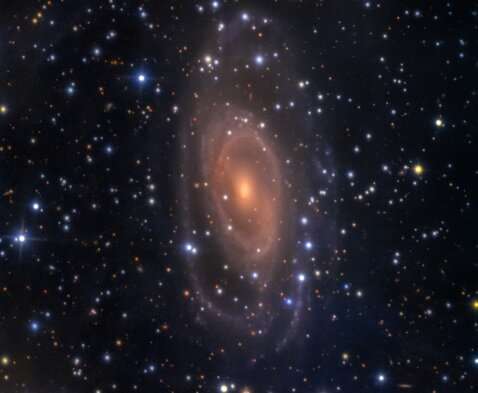Composite r, g, z-band image of UGC 1378. North is up, east is left, the image size is 7.2×10.1 arcmin. Credit: Saburova et al., 2019.
Russian astronomers have observed UGC 1378—an unusual, massive gas-rich galaxy with extended gaseous and low-surface brightness stellar discs. Results of the new research, presented in a paper published August 29, provide more insights into the nature of this rare type of galaxy.
Giant low-surface brightness (gLSB) galaxies with giant gaseous and stellar discs are very rare. Given that the formation and evolution of these discs in such galaxies is not well understood, astronomers are still searching for new objects of this type to investigate them in detail.
Located some 126 million light years away, UGC 1378 is a barred spiral galaxy of type SBa (with tightly bound arms of the spiral). Observations have shown that it is an unusual massive gas-rich gLSB system hosting gaseous and low-surface brightness stellar discs.
What puzzles astronomers is UGC 1378's neutral hydrogen (HI) gas content, which is higher than expected relative to its stellar mass. Moreover, the formation scenario of this galaxy is also uncertain. It is assumed that this gLSB system is most likely a result of a major merger in which an extended disc formed from an ample supply of gas cooled down at the late stage of a merger.
In order to resolve these uncertainties, a team of researchers led by Anna Saburova of the Lomonosov State University in Moscow, Russia, decided to conduct deep spectroscopic and multi-band imaging observations of UGC 1378. For this purpose they employed 6-m Russian telescope of the Special Astrophysical Observatory in southern Russia and the 6.5-m telescope of the MMT Observatory at Mt.Hopkins, Arizona.
"We describe observations of UGC 1378, including deep spectroscopy with the Russian 6-m telescope and multi-band imaging with Binospec at the MMT," the astronomers wrote in the paper.
The observations unveiled the complex structure of UGC 1378, including high-surface brightness (HSB) pseudo-bulge and HSB disc with a bar, rings and spiral arms. Moreover, the observational campaign clearly reveal the presence of a gas-rich gLSB disc with spiral arms and a radius of about 163,000 light years.
The global star formation rate (SFR) for UGC 1378 is estimated to be between 1.2 and 2.3 solar masses per year, which is close to that of the Milky Way galaxy. However, the LSB disc was found to have lower SFR surface density than expected from its gas density as for most gLSB galaxies. This, according to the authors of the paper, suggests recent gas accretion.
The study found that the dark matter halo dominates the mass inside the giant LSB disc radius of UGC 1378. Moreover, the ratio of dark to luminous mass is close to 2.0 within the HSB part of the galaxy, which is typical for normal spiral galaxies.
Most importantly, the research found that the stellar velocity dispersion of the HSB disc is close to that expected for its marginal gravitational stability. This, according to the astronomers excludes the possibility that UGC 1378 is a result of recent major mergers. Hence, taking into account the new results, they propose some other explanation.
"We suggest that the formation of UGC 1378 occurred in two stages. The first stage, in common with Milky Way-type galaxies, included several episodes of merging during which the HSB part formed and likely most satellites were accreted. In the second stage gLSB stellar and gaseous discs were formed by accretion of metal-poor gas from a cosmic filament," the researchers concluded.
More information: Anna Saburova, et al. UGC 1378—a Milky Way-sized galaxy embedded in a giant low-surface brightness disc. arXiv:1908.11383v1 [astro-ph.GA]: arxiv.org/abs/1908.11383
© 2019 Science X Network
























